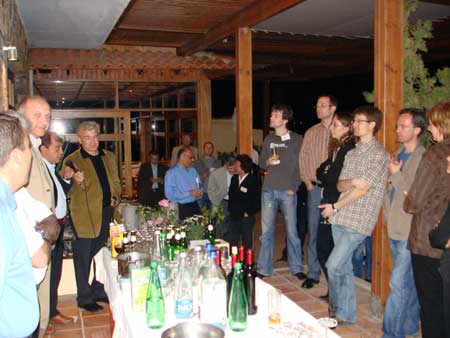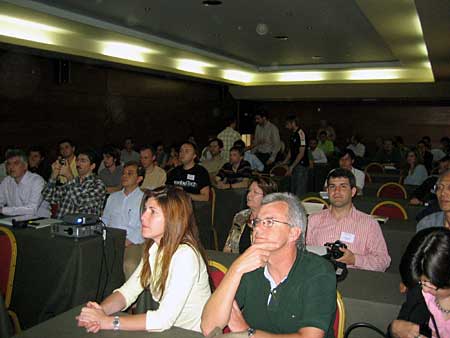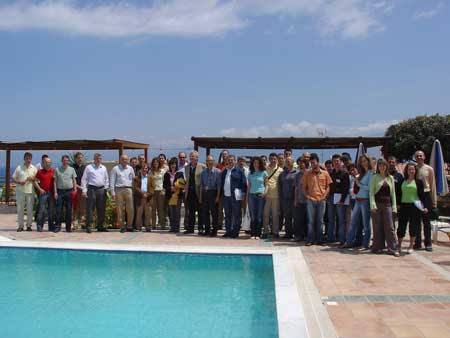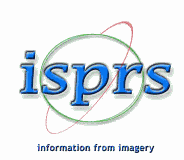|
By Martin Sauerbier
Summary:
The International Summer School on "Digital Recording and 3D Modeling", organised by ISPRS Commission VI SIG "Technology Transfer Caravan", Aristotle University of Thessaloniki and ETH Zurich, attracted participants from all over the world. During one week, 3D measurement and modeling techniques, processing methods and sensors were introduced by well-known experts.
 From 24th until 29th of April, the International Summer School on "Digital Recording and 3D Modeling" took place in Aghios Nikolaos, Crete (Greece), organized by the ISPRS Commission VI Special Interest Group "Technology Transfer Caravan", the Department of Rural and Surveying Engineering of the Aristotle University of Thessaloniki and the Chair of Photogrammetry and Remote Sensing of ETH Zurich. Thanks to the sponsorship granted by EPOCH (European Research Network on Excellence in Processing Open Cultural Heritage), the Aristotle University of Thessaloniki, the Japan International Cooperation Agency and the Municipality of Aghios Nikolaos, a programme covering a wide variety of technologies, methods and sensors as well as applications related to the field of digital 3D recording and modeling could be arranged. The 11 invited lecturers, experts in their domain each, instructed the 80 participants in the basic methodologies and latest developments concerning photogrammetric sensors and processing and airborne and terrestrial 3D laserscanning. The unexpected high number of attendees shows the growing interest in 3D data acquisition and processing technologies in various, research and application related, fields. The participants mostly came from european countries, 48 of them from Germany, Greece, Italy and Switzerland, but also attendees from asian countries such as Malaysia, Taiwan and Japan, Australia and the U.S. could be welcomed. In terms of their employment as well as their educational backgrounds, the attending colleagues formed a quite heterogeneous group assembled from universities (63), private companies (8), public organisations (6) and research organisations (3), being active in such diverse fields as archaeology, architecture, computer science and computer vision, geomatics and others more. From 24th until 29th of April, the International Summer School on "Digital Recording and 3D Modeling" took place in Aghios Nikolaos, Crete (Greece), organized by the ISPRS Commission VI Special Interest Group "Technology Transfer Caravan", the Department of Rural and Surveying Engineering of the Aristotle University of Thessaloniki and the Chair of Photogrammetry and Remote Sensing of ETH Zurich. Thanks to the sponsorship granted by EPOCH (European Research Network on Excellence in Processing Open Cultural Heritage), the Aristotle University of Thessaloniki, the Japan International Cooperation Agency and the Municipality of Aghios Nikolaos, a programme covering a wide variety of technologies, methods and sensors as well as applications related to the field of digital 3D recording and modeling could be arranged. The 11 invited lecturers, experts in their domain each, instructed the 80 participants in the basic methodologies and latest developments concerning photogrammetric sensors and processing and airborne and terrestrial 3D laserscanning. The unexpected high number of attendees shows the growing interest in 3D data acquisition and processing technologies in various, research and application related, fields. The participants mostly came from european countries, 48 of them from Germany, Greece, Italy and Switzerland, but also attendees from asian countries such as Malaysia, Taiwan and Japan, Australia and the U.S. could be welcomed. In terms of their employment as well as their educational backgrounds, the attending colleagues formed a quite heterogeneous group assembled from universities (63), private companies (8), public organisations (6) and research organisations (3), being active in such diverse fields as archaeology, architecture, computer science and computer vision, geomatics and others more.
 During the icebreaker party on Monday evening, the participants were welcomed by the organisers, Prof. Dr. Armin Gruen (ETH Zurich) and Prof. Dr. Petros Patias (Aristotle University of Thessaloniki), the Vice Mayor of Aghios Nikolaos, Mr. Manolis Thrapsaniotis and the President of the Town Hall Council, Mr. Panikos Karatzis. On Tuesday morning, after an introduction by Prof. Dr. Gruen, Prof. Dr. Patias and Prof. Dr. Murai (Em. University of Tokyo) was given during the opening ceremony, the technical programme started with lectures related to photogrammetric sensors, i.e. on high resolution satellite sensors (Dr. E. Baltsavias, Prof. C. Fraser) and digital aerial cameras (Prof. Dr. Gruen, Dr. M. Pateraki), direct georeferencing (Prof. D. Tsoulis) and camera calibration (A. Gruen, C. Fraser). On the second day, the lectures dealt with three main topics: photogrammetric processing, especially image matching and DSM generation (M. Pateraki) and automated / semi-automated object extraction (E. Baltsavias, A. Gruen), 3D modeling and visualization (F. Remondino) and finally an overview of terrestrial 3D laserscanning systems given by F. Blais concluded the first part of the technical programme. During the icebreaker party on Monday evening, the participants were welcomed by the organisers, Prof. Dr. Armin Gruen (ETH Zurich) and Prof. Dr. Petros Patias (Aristotle University of Thessaloniki), the Vice Mayor of Aghios Nikolaos, Mr. Manolis Thrapsaniotis and the President of the Town Hall Council, Mr. Panikos Karatzis. On Tuesday morning, after an introduction by Prof. Dr. Gruen, Prof. Dr. Patias and Prof. Dr. Murai (Em. University of Tokyo) was given during the opening ceremony, the technical programme started with lectures related to photogrammetric sensors, i.e. on high resolution satellite sensors (Dr. E. Baltsavias, Prof. C. Fraser) and digital aerial cameras (Prof. Dr. Gruen, Dr. M. Pateraki), direct georeferencing (Prof. D. Tsoulis) and camera calibration (A. Gruen, C. Fraser). On the second day, the lectures dealt with three main topics: photogrammetric processing, especially image matching and DSM generation (M. Pateraki) and automated / semi-automated object extraction (E. Baltsavias, A. Gruen), 3D modeling and visualization (F. Remondino) and finally an overview of terrestrial 3D laserscanning systems given by F. Blais concluded the first part of the technical programme.
On Thursday 27th, an excursion was scheduled. In the morning, the first destination after a boat trip was the island of Spinalonga. During a guided tour around the island, the summer school participants were introduced to the changeful history of Spinalonga, which was developed as a venecian fortress, later in ottoman occupancy before it returned to greek possession in the 19th century again, when it was used as a residency for lepers. After lunch in a restaurant near the seaside in Elounda, the tour continued by bus to the monastery of Moni Aretiou, where the participants were warmly welcomed with drinks and pastries by the monks, who also gave an insight in everyday life in an orthodox monastery. Afterwards, a bus tour through the Cretan Mountains towards the Byzantine Basilika of Panagia Kera, including a guided visit, and a walk through the pictorial village of Latsida. The excursion ended with a cretan diner, accompanied by excellent cretan musicians in a typical restaurant.
 On the following day, the technical programme continued with talks on digital camera calibration (C. Fraser, H. Hanley), 3D acquisition and modeling of close range objects (F. Blais), registration and modeling of aerial laser scanner data (Dr. C. Brenner) and panoramic imaging (J. Amiri Parian). In addition to the lectures, three demo sessions on Tuesday, Wednesday and Friday allowed the participants to demonstrate own applications and software modules to the interested audience, an opportunity that was utilized in order to show 11 different demos with a wide variety of topics. On Saturday morning, the summer school programme concluded with a second lecture on aerial laser scanning (C. Brenner) and an overview of applications by P. Patias and S. Murai. In the closing session, Prof. Dr. A. Gruen reported about plans for a subsequent summer school in 2007 and initiated a discussion about the content and the mode of lectures in order to satisfy the needs of the heterogeneous target group. As a conclusion it can be stated that all participants appreciated the summer school as it provided a broad overview of 3D data acquisition, processing, modeling and visualization technologies and offered a good opportunity in order to bring together interested researchers from various disciplines and countries all over the world. On the following day, the technical programme continued with talks on digital camera calibration (C. Fraser, H. Hanley), 3D acquisition and modeling of close range objects (F. Blais), registration and modeling of aerial laser scanner data (Dr. C. Brenner) and panoramic imaging (J. Amiri Parian). In addition to the lectures, three demo sessions on Tuesday, Wednesday and Friday allowed the participants to demonstrate own applications and software modules to the interested audience, an opportunity that was utilized in order to show 11 different demos with a wide variety of topics. On Saturday morning, the summer school programme concluded with a second lecture on aerial laser scanning (C. Brenner) and an overview of applications by P. Patias and S. Murai. In the closing session, Prof. Dr. A. Gruen reported about plans for a subsequent summer school in 2007 and initiated a discussion about the content and the mode of lectures in order to satisfy the needs of the heterogeneous target group. As a conclusion it can be stated that all participants appreciated the summer school as it provided a broad overview of 3D data acquisition, processing, modeling and visualization technologies and offered a good opportunity in order to bring together interested researchers from various disciplines and countries all over the world.
|

 From 24th until 29th of April, the International Summer School on "Digital Recording and 3D Modeling" took place in Aghios Nikolaos, Crete (Greece), organized by the ISPRS Commission VI Special Interest Group "Technology Transfer Caravan", the Department of Rural and Surveying Engineering of the Aristotle University of Thessaloniki and the Chair of Photogrammetry and Remote Sensing of ETH Zurich. Thanks to the sponsorship granted by EPOCH (European Research Network on Excellence in Processing Open Cultural Heritage), the Aristotle University of Thessaloniki, the Japan International Cooperation Agency and the Municipality of Aghios Nikolaos, a programme covering a wide variety of technologies, methods and sensors as well as applications related to the field of digital 3D recording and modeling could be arranged. The 11 invited lecturers, experts in their domain each, instructed the 80 participants in the basic methodologies and latest developments concerning photogrammetric sensors and processing and airborne and terrestrial 3D laserscanning. The unexpected high number of attendees shows the growing interest in 3D data acquisition and processing technologies in various, research and application related, fields. The participants mostly came from european countries, 48 of them from Germany, Greece, Italy and Switzerland, but also attendees from asian countries such as Malaysia, Taiwan and Japan, Australia and the U.S. could be welcomed. In terms of their employment as well as their educational backgrounds, the attending colleagues formed a quite heterogeneous group assembled from universities (63), private companies (8), public organisations (6) and research organisations (3), being active in such diverse fields as archaeology, architecture, computer science and computer vision, geomatics and others more.
From 24th until 29th of April, the International Summer School on "Digital Recording and 3D Modeling" took place in Aghios Nikolaos, Crete (Greece), organized by the ISPRS Commission VI Special Interest Group "Technology Transfer Caravan", the Department of Rural and Surveying Engineering of the Aristotle University of Thessaloniki and the Chair of Photogrammetry and Remote Sensing of ETH Zurich. Thanks to the sponsorship granted by EPOCH (European Research Network on Excellence in Processing Open Cultural Heritage), the Aristotle University of Thessaloniki, the Japan International Cooperation Agency and the Municipality of Aghios Nikolaos, a programme covering a wide variety of technologies, methods and sensors as well as applications related to the field of digital 3D recording and modeling could be arranged. The 11 invited lecturers, experts in their domain each, instructed the 80 participants in the basic methodologies and latest developments concerning photogrammetric sensors and processing and airborne and terrestrial 3D laserscanning. The unexpected high number of attendees shows the growing interest in 3D data acquisition and processing technologies in various, research and application related, fields. The participants mostly came from european countries, 48 of them from Germany, Greece, Italy and Switzerland, but also attendees from asian countries such as Malaysia, Taiwan and Japan, Australia and the U.S. could be welcomed. In terms of their employment as well as their educational backgrounds, the attending colleagues formed a quite heterogeneous group assembled from universities (63), private companies (8), public organisations (6) and research organisations (3), being active in such diverse fields as archaeology, architecture, computer science and computer vision, geomatics and others more. During the icebreaker party on Monday evening, the participants were welcomed by the organisers, Prof. Dr. Armin Gruen (ETH Zurich) and Prof. Dr. Petros Patias (Aristotle University of Thessaloniki), the Vice Mayor of Aghios Nikolaos, Mr. Manolis Thrapsaniotis and the President of the Town Hall Council, Mr. Panikos Karatzis. On Tuesday morning, after an introduction by Prof. Dr. Gruen, Prof. Dr. Patias and Prof. Dr. Murai (Em. University of Tokyo) was given during the opening ceremony, the technical programme started with lectures related to photogrammetric sensors, i.e. on high resolution satellite sensors (Dr. E. Baltsavias, Prof. C. Fraser) and digital aerial cameras (Prof. Dr. Gruen, Dr. M. Pateraki), direct georeferencing (Prof. D. Tsoulis) and camera calibration (A. Gruen, C. Fraser). On the second day, the lectures dealt with three main topics: photogrammetric processing, especially image matching and DSM generation (M. Pateraki) and automated / semi-automated object extraction (E. Baltsavias, A. Gruen), 3D modeling and visualization (F. Remondino) and finally an overview of terrestrial 3D laserscanning systems given by F. Blais concluded the first part of the technical programme.
During the icebreaker party on Monday evening, the participants were welcomed by the organisers, Prof. Dr. Armin Gruen (ETH Zurich) and Prof. Dr. Petros Patias (Aristotle University of Thessaloniki), the Vice Mayor of Aghios Nikolaos, Mr. Manolis Thrapsaniotis and the President of the Town Hall Council, Mr. Panikos Karatzis. On Tuesday morning, after an introduction by Prof. Dr. Gruen, Prof. Dr. Patias and Prof. Dr. Murai (Em. University of Tokyo) was given during the opening ceremony, the technical programme started with lectures related to photogrammetric sensors, i.e. on high resolution satellite sensors (Dr. E. Baltsavias, Prof. C. Fraser) and digital aerial cameras (Prof. Dr. Gruen, Dr. M. Pateraki), direct georeferencing (Prof. D. Tsoulis) and camera calibration (A. Gruen, C. Fraser). On the second day, the lectures dealt with three main topics: photogrammetric processing, especially image matching and DSM generation (M. Pateraki) and automated / semi-automated object extraction (E. Baltsavias, A. Gruen), 3D modeling and visualization (F. Remondino) and finally an overview of terrestrial 3D laserscanning systems given by F. Blais concluded the first part of the technical programme. On the following day, the technical programme continued with talks on digital camera calibration (C. Fraser, H. Hanley), 3D acquisition and modeling of close range objects (F. Blais), registration and modeling of aerial laser scanner data (Dr. C. Brenner) and panoramic imaging (J. Amiri Parian). In addition to the lectures, three demo sessions on Tuesday, Wednesday and Friday allowed the participants to demonstrate own applications and software modules to the interested audience, an opportunity that was utilized in order to show 11 different demos with a wide variety of topics. On Saturday morning, the summer school programme concluded with a second lecture on aerial laser scanning (C. Brenner) and an overview of applications by P. Patias and S. Murai. In the closing session, Prof. Dr. A. Gruen reported about plans for a subsequent summer school in 2007 and initiated a discussion about the content and the mode of lectures in order to satisfy the needs of the heterogeneous target group. As a conclusion it can be stated that all participants appreciated the summer school as it provided a broad overview of 3D data acquisition, processing, modeling and visualization technologies and offered a good opportunity in order to bring together interested researchers from various disciplines and countries all over the world.
On the following day, the technical programme continued with talks on digital camera calibration (C. Fraser, H. Hanley), 3D acquisition and modeling of close range objects (F. Blais), registration and modeling of aerial laser scanner data (Dr. C. Brenner) and panoramic imaging (J. Amiri Parian). In addition to the lectures, three demo sessions on Tuesday, Wednesday and Friday allowed the participants to demonstrate own applications and software modules to the interested audience, an opportunity that was utilized in order to show 11 different demos with a wide variety of topics. On Saturday morning, the summer school programme concluded with a second lecture on aerial laser scanning (C. Brenner) and an overview of applications by P. Patias and S. Murai. In the closing session, Prof. Dr. A. Gruen reported about plans for a subsequent summer school in 2007 and initiated a discussion about the content and the mode of lectures in order to satisfy the needs of the heterogeneous target group. As a conclusion it can be stated that all participants appreciated the summer school as it provided a broad overview of 3D data acquisition, processing, modeling and visualization technologies and offered a good opportunity in order to bring together interested researchers from various disciplines and countries all over the world.